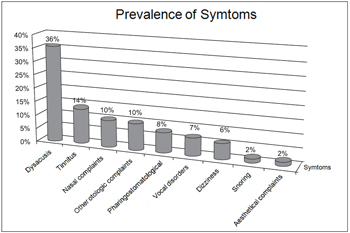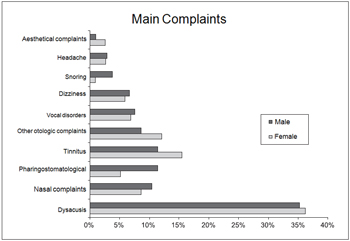INTRODUCTION The life expectancy of geriatric patients presented an important increase in the last decades. It is estimated that the elderly population will double until 2050, reaching 15% of the total Brazilian population. With such increase, medical practice will have to suffer adaptations to such new quantity(1).
Geriatric patients present 3.5 times more health problems where compared to patients who are younger than 65 years old. Four out of five patients with more than 65 years of age refer at least one chronic condition, many of whom presenting more than one associated condition. Such patients frequently use multiple medications and are more susceptible to their adverse effects(2,3).
Health problems of elderly patients cause dependency and depression, which added to Otorhinolaryngological problems, making the social interaction of geriatric patients worse(2,4).
One of the main objectives of elderly patients' care is the maintenance of social independency, of mobility and of cognitive abilities(5). The dependency variable degrees demand an individualized identification of their needs. Consequently, it is important to evaluate not only the medical treatment of geriatric patients, but also the social-economical effects of the demographic change presented(1,6).
This study aimed at describing the prevalence of geriatric population and their main complaints in Otorhinolaryngology clinic.
CASUISTICS AND METHODMedical records of patients with 60 years of age or more who received initial attention at the Otorhinolaryngology clinic and university hospital were reviewed from January 22, 2007 until April 20, 2007. The cases were analyzed according to gender, age, main complaint and associated Otorhinolaryngological complaints.
Out of the selected group, gender, age, main complaint and associated otorhinolaryngological complaints were considered relevant according to guided anamnesis. Firstly, the total number of patients who received attention during that period was compared to the study group. From that subgroup, the prevalence of patients in relation to sex was analyzed. After that, the main complaints were identified and co-related to the ones who had associated complaints. Data were gathered and rearranged on Tables so that results were compared.
RESULTSDuring the study period, 2,048 patients received initial attention at the Otorhinolaryngology clinic of a university hospital, out of whom 17.52% (n=359) were 60 years old or more. Out of the 359 medical records, only 221 were analyzed. The other ones were excluded due to lack of anamnesis data, which would harm the study.
The geriatric patients aged from 60 to 92 years old, with average age of 69.83 years (Graph 1). There was small prevalence of 189 female patients (52.49%), with lower average age (68.70 years) than the 170 male patients (71.07 years).

Graph 1. Number of patients according to age.
Considering the whole group (Graph 2), the prevalence of symptoms found were: dysacusis 36% (CI 29-42%); tinnitus 14% (CI 9-18%); other otologic complaints (otalgia, cerumen, external auditory channel prutitus, otorrhea, otitis, aural fullness, ear wound) 10% (CI 6-14%); nasal complaints (nasal obstruction, rhinorrhea, rhinitis, rhino-sinusitis, epitaxis, nose pain) 10% (CI 6-13%); pharingostomatological complaints (tonsillitis, catarrh, odynophagia, dysphagia, cough, pharyngeal balloon, glossodynia, halitosis) 8% (CI 5-12%); dizziness 6% (CI 3-10%); vocal disorders (dysphonia, vocal cords cyst, laryngitis) 7% (CI 4-11%). The other reported complaints added up 10%). Other associated pathologies were reported in 130 cases (36.20%). (CI 95%)

Graph 2. Prevalence of symptoms in the total group.
Separately analysing the main complaints according to patients' gender (Graph 3), there were differences in relation to the whole group. The main female complaints were: dysacusis 36.2% (CI 27%-45%); tinnitus 15.5% (CI 9%-22%); other otological complaints 12.1% (CI 6%-18%); nasal complaints 8.6% (CI 4%-14%); vertigo 6% (CI 2%-10%); and pharingostomatological complaints 5.2% (IC 1%-9%). The other reported complaints added up 22.5%. (CI 95%)

Graph 3. Frequency relation of main complaints for male and female group.
In terms of the main male complaints: dysacusis 35.2% (CI 26%-44%); tinnitus and pharingostomatological complaints, both with 11.4% (CI 5%-18%); other otological complaints 8.6% (CI 3%-14%); nasal complaints 10.5% (CI 5%-16%); vocal complaints 7.6% (CI 3%-13%); and other complaints which added up 15.4%.. (CI 95%)
The otoneurological and ontological affections represented most of co-morbidities with 66%, directly co-related to the prevalence of the main complaints.
The laryngological affections were the second most representative complaint, matching the rhinological complaints, which respectively represent 15% and 10%. (CI 95%)
DISCUSSIONIn Brazil, just like in other countries, there is an increase in the number of elderly individuals. With the increase of such population segment, there is an impact in both society and medicine. Geriatric patients are the ones who use medical care the most. Literature data affirm that a population with 12% of elderly individuals uses 33% of medical time(6). In this study, the number of attentions for geriatric patients was 17.53% of the total outpatients in the study period.
Several social-economical factors must be considered in the care of such kind of patient, once aging brings a higher number of co-morbidities, more frequently using health system and financial resources. Literature data consider auditory loss, dysphalgia, balance disorders, nasal complaints, vocal disorders, head and neck cancer and aesthetical complaints the most frequent complaints among elderly individuals (3) In descending prevalence order, the complaints were: dysacusis, tinnitus, other ontological complaints, nasal complaints and pharyngeosmatological complaints.
Presbyacusis is one of the most common alterations related to aging(2). In the analysis performed, 36% of the patients complained of hearing problems, which matches international findings in which 30% of the population presented auditory loss which affects their communication capacity. The auditory loss related to aging affects quality of life of those who do not have access to treatment and consequently become isolated people.
Otoneurological problems are the main reasons which may lead elderly individuals to Otorhinolaryngology attention. The number of falls among elderly individuals grows geometrically with aging and is an important cause of morbidity, just like tinnitus(4,5). Literature data show that 20% of the population which is older than 50 years old presents tinnitus. This study revealed that, 6% of the patients studied presented dizziness as main complaint and 14% presented tinnitus as main complaint. However, if the dysacusis complaint is better investigated, it would be expected to find a total increase of otoneurological complaints when added to the patients carrying dizziness and tinnitus.
Dysphagia is another frequent problem in elderly individuals(6). There are several possible causes, but the neoplasia hypothesis cannot be forgotten. 5% of the elderly individuals who received attention complained of dysphagia.
Nasal obstruction, rhinorrhea, epistaxe and olfaction disorders are frequent complaints, which correspond to 10% of total complaints. Nasal physiology disorders may cause such complaints, as well as presence of neoplasia or use of medication, which is very frequent in such group of patients(6).
Voice disorders are observed in 12% of elderly patients, according to literature data and in 7% of this study data. There are several changes related to aging which occur in vocal cords and which may cause patients' symptoms, besides neurologic disorders which may bring changes in vocal function(2).
Head and neck cancer is frequently found in elderly population and must be excluded from each patient who carries one of the complaints mentioned above.
The increase of additional lifetime is also followed by a longer period of healthy and active life when compared to past decades, as well as the increase of aesthetical complaints(1). The elderly patients care more about their appearance and cause more and more the increase of aesthetical procedures. Out of the total, only 2% had aesthetical complaint as their main complaint. If we observe such data only in the female group, such percentage grows to 2.6%, what confirms that women are, without question, more worried about appearance than men.
CONCLUSIONThis study concludes that the most frequent complaints in the studied population are of otologic origin (66%), and there is no significant difference between male and female group.
Co-morbidity, which was evaluated in secondary complaints, makes ontological changes even more relevant.
It is important to be aware of epidemiological data in order to provide better efficiency in the treatment of such group of patients, which is considerably increasing.
REFERENCES 1. Shapiro DP. Geriatric demographics and the practice of otolaryngology. Ear Nose Throat J. 1999 Jun;78(6):418-21.
2. Bora H, Bandyopadhyay SN, Basu SK, Majhi PK. Geriatric problems in otolaryngology. J Indian Med Assoc. 2004 Jul;102(7):366, 368, 370.
3. Onzotto G, Koffi-Aka V, Yotio A, Ehouo F, Adjoua B, Bamba M. Oto-rhino-laryngology and geriatrics in the Ivory Coast. Rev Laryngol Otol Rhinol (Bord). 2002;123(2):119-23.
4. Lawson J, Fitzgerald J, Birchall J, Aldren CP, Kenny RA. Diagnosis of geriatric patients with severe dizziness. J Am Geriatr Soc. 1999 Jan;47(1):12-7.
5. Weindruch R, Korper SP, Hadley E. The prevalence of dysequilibrium and related disorders in older persons. Ear Nose Throat J. 1989 Dec;68(12):925-9.
6. Clarke LK. Geriatric otorhinolaryngology: embracing the challenge. ORL Head Neck Nurs. 2002 Spring;20(2):6.
1. Otorhinolaryngologist doctor. Otorrhinolaryngology residence preceptor at Santa Casa de Misericórdia de Curitiba.
2. Otorhinolaryngologist resident doctor. Otorrhinolaryngology resident at Santa Casa de Misericórdia de Curitiba.
3. Medicine student.
4. Medical doctor
Santa Casa de Misericórdia de Curitiba
Scheila Maria Gambeta Sass
Address: Rua Dr Pedrosa, 264 - apto 302 A - Centro - Curitiba/PR - CEP 80420-120 - Cel phone: (41) 9162-9939 - Fax: (42) 3232-2735 - E-mail: scheilasass@yahoo.com.br
This article was submitted at SGP (Publication Management System) of R@IO on February 17, 2008 and approved on March 5th, 2008, 16:21:19